North American
P-51H Mustang
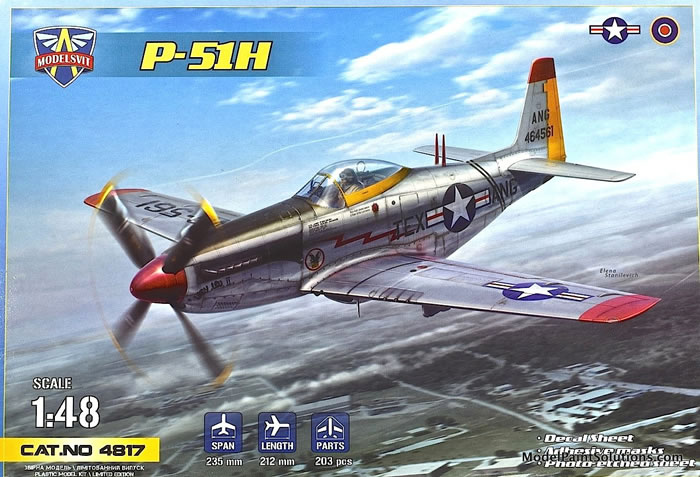
Modelsvit, 1/48 scale
S
u m m a r y : |
Description and Item No.: |
Modelsvit Kit No. 4817 - North American P-51H Mustang |
Contents and Media: |
130 parts in grey styrene, 9 in clear, and a PE fret with ~35 parts. In addition, masks and one decal sheet with markings for 4 airframes are included. |
Price: |
£31.33 Plus Shipping from Hannants |
Scale: |
1/48 |
Review Type: |
First Look |
Advantages: |
The model represents a new mold P-51H in 1/48 that features a high level of detail, PE, masks, and colorful decals. |
Disadvantages: |
Being a limited run kit, extra effort will be required for parts cleanup and test fitting. |
Recommendation: |
This is a beautiful model bristling with details. Although it is a limited-run kit, the fidelity of detail and the crispness of the moldings bely that moniker. A quick test fit of the prepped fuselage halves revealed an excellent fit with all the panels lining up perfectly. I suspect this kit will require some work given the complexity and parts count. The payoff, however, will be an amazingly detailed and colorful model of a lesser-known ‘Stang not often seen on the show tables. |
Reviewed by John Miller
Once again the evil proprietor of Skyway Hobby Shop laid in wait as I made my approach. Unaware, I entered the shop and before I knew it this new (and quite amazing) North American P-51H from Modelsvit was thrust into my hands and a voice was saying, “You need one these”………….
And, as a matter of fact, I did. This new H model ‘Stang is quite impressive in it’s level of detail and will be amazing when completed. “Detailed” is the word with a total of ~175 parts (including PE). That’s a lot of parts for a 1/48th single-seater. I have to commend the folks at Modelsvit for tackling a lesser-known variant of the ‘Stang family with such enthusiasm. Well done, guys!
Background
The P-51H (NA-126) was the final production Mustang, embodying the experience gained in the development of the XP-51F and XP-51G. The P-51H came too late to participate in World War II, but it brought the development of the Mustang to a peak as one of the fastest production piston-engine fighters to see service.
The P-51H used the new V-1650-9 engine, a version of the Merlin that included Simmons automatic supercharger boost control with water injection, allowing War Emergency Power as high as 2,218 hp (1,500 kW). Differences between the P-51D included lengthening the fuselage and increasing the height of the tailfin, which reduced the tendency to yaw. The canopy resembled the P-51D style, over a raised pilot's position. Service access to the guns and ammunition was also improved. The new airframe was several hundred pounds lighter, had extra power, and a more streamlined radiator. These changes made the P-51H faster than the P-51D, able to reach 472 mph (760 km/h; 410 kn) at 21,200 ft (6,500 m).
The P-51H was designed to complement the P-47N as the primary aircraft for the invasion of Japan. The two thousand ordered were to be manufactured at Inglewood. Production was just ramping up with 555 delivered when the war ended.
Additional orders, already on the books, were canceled. With the cutback in production, variants of the P-51H with different versions of the Merlin engine were produced in either limited numbers or terminated. These included the P-51L, similar to the P-51H but utilizing the 2,270 hp (1,690 kW) V-1650-11 engine, which was never built; and its Dallas-built version, the P-51M, or NA-124, which utilized the V-1650-9A engine lacking water injection and therefore rated for lower maximum power, of which one was built out of the original 1629 ordered, serial number 45-11743.

Although some P-51Hs were issued to operational units, none saw combat in World War II, and in postwar service, most were issued to reserve units. One aircraft was provided to the RAF for testing and evaluation. Serial number 44-64192 was designated BuNo 09064 and used by the U.S. Navy to test transonic airfoil designs and then returned to the Air National Guard in 1952. The P-51H was not used for combat in the Korean War despite its improved handling characteristics, since the P-51D was available in much larger numbers and was a proven commodity.
Many of the aerodynamic advances of the P-51 (including the laminar flow wing) were carried over to North American's next generation of jet-powered fighters, the Navy FJ-1 Fury and Air Force F-86 Sabre. The wings, empennage and canopy of the first straight-winged variant of the Fury (the FJ-1) and the unbuilt preliminary prototypes of the P-86/F-86 strongly resembled those of the Mustang before the aircraft were modified with swept-wing designs.
(Edited from Wikipedia)
The nicely done box art depicts a colorful P-51H of the Texas Air National Guard circa 1953. Upon opening the box the initial impression is one of complexity. A weekend shake ‘n bake this is not.
On the eight grey styrene sprues are ~130 parts that are mostly free of flash. There will be a little clean up and refreshing (this is a limited-run kit after all) but the moldings are surprisingly crisp. The surface details, especially the rivets, are particularly well done and reminiscent of the rivet work on Eduard’s line of 48th Me-109’s. Similarly the inscribed panel lines are crisply rendered and even in depth. Those surface details rendered in relief are done so in a scale appropriate manner. True to its limited-run nature, there are no alignment pins and some of the sprue gates are a bit thick.
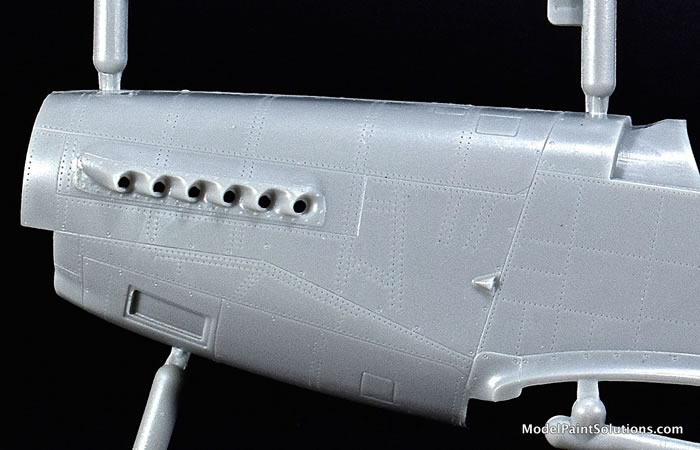
The kit's engineering is conventional entailing the assembly of a cockpit tub and tail wheel well assembly that are trapped between fuselage halves thence joined to a full-span lower wing with left and right upper halves.
The cockpit is beautifully detailed right out of the box and will look awesome when complete. The detail here is comparable to that seen with some after market cockpit sets: very nice.
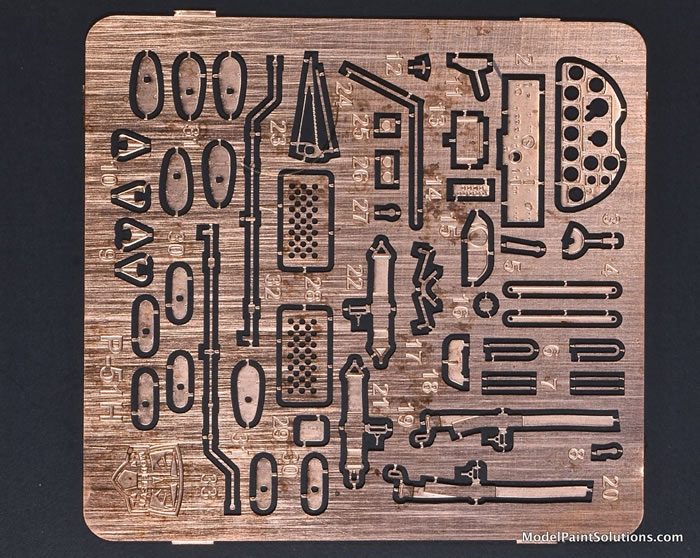
The main wheel wells are composed of 12 parts and have a level of detail comparable to the cockpit. Ditto that for the 5-piece tail wheel well, which has all the internal structures including the tail wheel shock absorber strut and its separate mount.
The flaps, ailerons, horizontal stabilizers, and elevators are all comprised of halves. All the control surfaces are poseable except the rudder, which is integral with the fuselage.
Underwing stores comprised of drop tanks (2) and underwing HVAR rockets (6) are provided.
The canopy parts are crystal clear with scale appropriate framing.
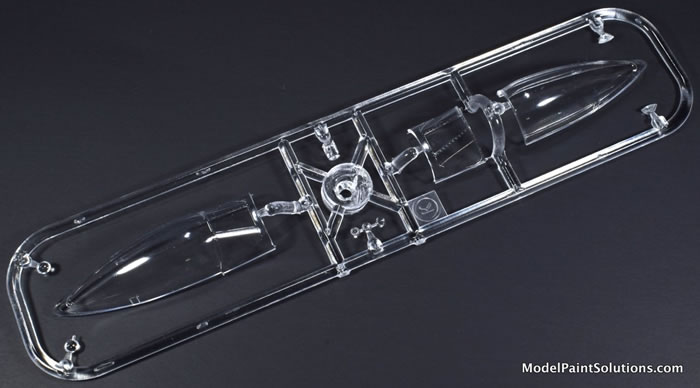
In addition to a single-piece closed canopy, a separate windscreen and rear canopy section are included for those who like their canopies posed open.
Markings:
The decals, by Modelsvit, are well printed with good registration and color density.
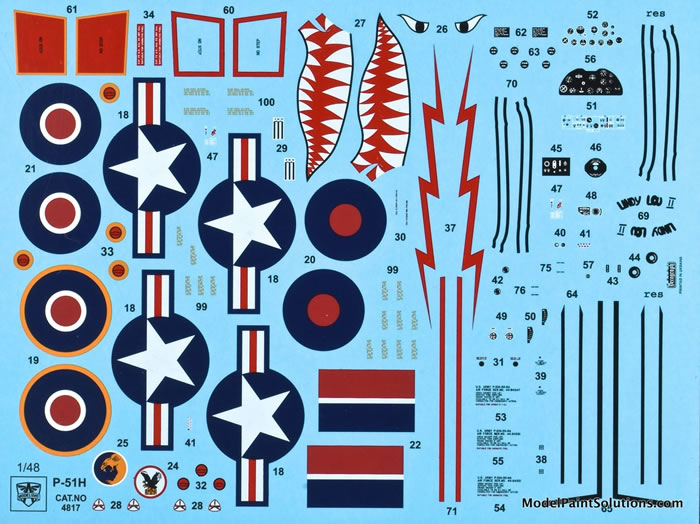
Airframe stencil data and markings for four airframes are provided as follows:
-
P-51H, 44-64561, 182nd FBS, Texas ANG, 1953
-
P-51H, 44-64347, 101st FIS, Massachusetts ANG, 1951
-
P-51H, 44-64351, 133 FIS, New Hampshire ANG, 1953
-
P-51H, KN987, RAF, 1945
This is a beautiful model bristling with details. Although it is a limited-run kit, the fidelity of detail and the crispness of the moldings bely that moniker. A quick test fit of the prepped fuselage halves revealed an excellent fit with all the panels lining up perfectly. I suspect this kit will require some work given the complexity and parts count. The payoff, however, will be an amazingly detailed and colorful model of a lesser-known ‘Stang not often seen on the show tables.
Highly Recommended!
For more on this review visit Modelpaintsolutions.com.
Review kit provided by my retirement fund, again.
Review Text and Images Copyright © 2020 by John Miller
Page Created 5 June, 2020
Last updated
5 June, 2020
Back to HyperScale Main Page
Back to Reviews Page

|
Home
| What's New |
Features |
Gallery |
Reviews |
Reference |
Forum |
Search